Leucojum vernum



Stemless / Acaulescent
A plant that has no stems, when the flower stalks and leaf blades are produced from ground level.
Clumping
A plant that when multiplies forms a clump.This herbaceous perennial has upright strap-like mid green leaves and form a spreading clump. It has drooping white bell-shaped green dotted flowers that appear in open clusters above the foliage from mid winter to early spring.
Leucojum vernum is naturally found from central Europe to regions of the Mediterranean growing in woodlands or around swamps and along river banks. It prefers a moderately to well drained organic rich moist fertile loamy soil with a pH range from 5.5 to 8.0, and tolerates chalky based soils. It grows in an open sunny to semi shaded wind protected position and is frost and drought tender.
Snow Flake is grown for its dainty flowers and clumping habit. It is planted in small or cottage gardens along perennial borders or used in drifts in woodland settings. It is also planted around water features and establishes from division in 1 to 2 years. The flowers are cut and used in floral arrangements and the plant may be grown in patio pots or under deciduous trees. It is ideal plant for a winter garden and prefers a moist sunny position. Once established it has a medium water requirement, (Scale: 2-drops from 3) preferring to have reliable moist organic rich soil for optimum growth.
I.D. 473
UK hardiness zone H5
Climate zones 1 - 6
USDA Zone 5-10
Leucojum (LOO-koh-jum) vernum (VER-num)
'Leucojum': from Greek leukos + ion - white violet; 'vernum': spring.
Amaryllidaceae (AM-ar-ee-LEE-da-AY-see-ee)
These plants have a perennial bulb with basal leaves and flowers that occur in umbles.
Distribution
This family of plants range from wet to dry environments.
Diagnostic Features
These plants have a bulb from which strap like leaves arise.
The flowers are symmetrical, bisexual and occur in umbel on unbranched peduncles that have large bracts at the base. The perianth segments are unfused, large and showy with some species having a corona arising as a result of the linked filaments.
There are six stamens and the ovary is inferior that consists of three carpels with 1 to 3 chambers each consisting of numerous ovules. They have an unbranched style that has three short lobes.
The fruit is either a capsule or berry and the numerous seeds contain an endosperm.
Note:
There are many showy and common species in this family.
This plant tolerates between USDA zones 5a to 10a and grows to 0.3 m (12 in)
Fahrenheit -20º to 35º F
These temperatures represent the lowest average.
Celsius -26.2º to 1.6º C
Attention
All photographs and data are covered by copyright. Apart from any fair dealing for the purpose of private study, research, reference or review, as permitted under the Copyright Act, no part may be reproduced by any means with out written permission. All inquiries should be addressed to plantfile.com attention Peter Kirkland.

Simple
The leaf that is not divided.
Lanceolate
Broadest at the centre, three or more times long as broad (Lance-shape).
Basal
When the leaves grow from the base of the plant or radically from the root-shoot point.
Entire
A leaf margin with no irregularities (smooth).
Campanulate
A flower forming a bell shape, (rounded base gradually enlarged) petals may be fused or absent (Eucalyptus species).
Umbel
When the pedicels arise from the same point on the peduncle.| Jan | Feb | Mar | Apr | May | Jun |
| Jul | Aug | Sep | Oct | Nov | Dec |
The nodding campanulate (bell-shaped) flowers are white with a single green dot on each of the 6 tepals. The flowers are solitary or are arranged in an umbel of 2 to 3 on a long slender pedicle and are held above the foliage on a leafless scape that is up to 300 mm (1 ft) tall. They appear from late winter to early spring.

Berry
A fleshy succulent indehiscent fruit, contains one or more seeds"Snow Flake is grown for its dainty flowers and clumping habit. It is planted in small or cottage gardens along perennial borders or used in drifts in woodland settings. It is also planted around water features and establishes from division in 1 to 2 years. The flowers are cut and used in floral arrangements and the plant may be grown in patio pots or under deciduous trees. It is ideal plant for a winter garden and prefers a moist sunny position.
Note:
Remove spent flowers to prolong the flowering period and remove only the spent foliage.
Lift and divide the bulbs when the foliage dies off and replant during autumn. When planting out space the bulbs 100 mm (4 in) apart and 50 mm (2 in) deep. The bulbs should be scooped.
Sow fresh seeds in a well-drained media and place in a cold frame to germinate in 2 - 4 weeks. Stored seeds require 2 - 3 months cold stratification and there should be sow thinly in a container and it left undisturbed for the first season.
Bulbs, Tubers and Corms (General)
This is an underground organ with a short fleshy stem and a flower primordium that is enclosed by fleshy scales. The structure of this monocotyledon is designed for food storage and reproduction.
Tunicate Bulbs; daffodils, tulip, onion
These bulbs have a dry outer layer that protects the fleshy concentric inner scales as in an onion forming a solid appearance.
Nontunicate Bulbs lilies
These bulbs have no protective dry outer layer and are easily damaged. The scales are separate and are attached to the basil plate so care should be taken to keep them moist, as drying is detrimental to their health. Roots appear from the base and in some cases from the stem, normally growing during mid summer to autumn.
Offsets or Bulblets
This type of propagation is used on many bulbs which are normally removed when the bulbs are lifted then planted as separate plants. Some plants require a few years to produce offsets and they can remain on the plant undisturbed for many seasons.
Tulip produces offsets which should be lifted when the foliage dies off and daffodil forms offsets (split) over several years. These offsets may be stored or planted up directly.
Lilies increase slowly but the bulb in some species may be split and the scales produce bulblets as with other lily species bulblets are produced at the base.
Stem Cuttings
Lily species may be grown from stem cuttings where bulblets form at the base of the stem or leaf-bud cuttings with a single leaf and an old stem heal, the bulblets will form in the axil of the leaf.
Basal Cuttage
This method includes 'scooping' and 'scoring' on larger bulbs 170 mm (6 7/10 in) diameter. Scooping is carried out with a curved blade removing the basal plate of the bulb. Adventitious bulblets develop on the exposed scales.
The scoring method involves three cuts through the basal plate of the bulb, which produces bulblets in the axils of the scales.
In both of these methods the bulbs are planted out for one to two seasons where the mother bulb disintegrates and the bulbils multiply then grow.
Leaf Cuttings
This method is used for blood lily, hyacinth and other species. Well-developed leaves are cut from the base, then cut into sections and planted in a rooting medium 30 mm deep. In a few weeks bulbils will develop at the base of the leaf. These are then potted up and grown on.
Bulb Cuttings
Narcissus, Hippeastrum, Cooperia and many other species may be propagated in this method.
The mature bulb is cut into eight to ten sections each containing a part of the basal plate. These are planted in a rooting medium vertically as to just show the tip and maintained in a warm environment. Bulbils will form at the basal plate with in a few weeks. After developing the bulbils are potted up.
Corm
The corm is a swollen base that is covered in a protective tunic, which prevents drying out. It is composed of scale like leaves that have nodes and internodes where axillary buds develop. There are two types of roots, fleshy contractile from the new corms and fibrous from the base of the mother corm.
After the foliage dies off the corm is lifted then allowed to stand after which old corms, new corms and cormels are separated.
The cormels are stored during winter and planted during spring after soaking in water for 2 to 3 days. These may be planted into containers or in a prepared bed and allowed to grow on for one season.
The corm may also be divided by cutting it into sections, which develop into new corms.
Tubers
This is a swollen underground stem that acts as a food storage organ with nodes and small buds as in the potato. Tubers may be propagated by either cutting the tuber in to pieces that contain buds (eyes) with sufficient stored food for growth or planted as a complete tuber.
Tuberous Roots and Stems.
These tuber roots differ in that there are no nodes or internodes and the buds are only produced at the crown with fibrous roots at the opposite end. The tuberous stems have a vertical orientation and arise from the first nodes as in Cyclamen species.
One or more bud is produced at the top of the crown and may be propagated by dividing the tuber so that it contains a shoot bud. Each section should be dried for a few days and stored in sawdust or vermiculite to avoid shrivelling.
In a warm humid environment the tubers will shoot.
Rhizomes
A rhizome is a stem that grows horizontally either below or on the surface of the soil with the shoots growing vertically as in bamboo and many grasses. The stems are composed of nodes and inter nodes giving it a segmented appearance.
Propagation is normally carried out by division during spring and autumn, by cutting the rhizome into sections each with at least one node. Placed on a moist bed or slightly buried and kept them warm which will produce roots, shoots from the nodes.
Pseudobulbs
This is a large fleshy section of the stem that may have one or several nodes. They are produced on orchids and may vary depending on the species. They are propagated from offsets, which develop at the nodes or by division of the rhizome containing pseudobulbs during the dormant period.
Propagation by Seed (General)
Germination
In order for a seed to germinate it must fulfil three conditions.
1. The embryo must be alive (a viable seed).
2. The seed must have no dormancy-inducing physiological, physical or chemical barrier to germination; also the seed must be nondormant.
3. The seed must have the appropriate environmental requirements, water, temperature and oxygen.
The interaction between these requirements and dormancy is complex and may lead to different environmental requirements that avoid the dormancy of a seed.
Sowing Seeds in Containers
There are two general methods for germinating seeds.
Seeds in a flat or germinating bed, through which seedlings are pricked-out then, transplanted into another flat with wider spacing or directly to an individual pot.
2. Sowing seeds by placing them in to flats with the appropriate spacing or into individual pots.
This method is normally carried out with medium to large seeds such as woody plants and plants that are difficult to transplant.
Seedling production normally occurs in a greenhouse / glasshouse, cold frames and on hot beds.
Method of Seed Sowing
Fine seed is sown in pots or flats that are no deeper than 70 to 80 mm. using a sterilised well-drained media (soil). Fill the container to 20 mm from the top and sprinkle sieved peat to 3 mm depth.
Press the media down level and firm with a piece of timber and then thoroughly moisten.
Mix the fine seed with washed sand and then sow thinly on the surface. These may be lightly covered with sand.
Larger seeds may be covered with media or a hole is dibbled and the seed is placed in the media.
Watering Methods
For watering you may either mist the containers from above or place the container in tepid water and allow the water to raise through the pot to the surface of the media, then drain away and do not fill to the top of the container.
Place a piece of glass over the pot and store in a protected warm environment (glasshouse).
Seeds germinate best in darkness so shade the containers if in direct sunlight.
After the seedlings have sprouted remove the glass and ease the seedlings into direct light.
When the seedlings are large enough prick them out and transplant into larger containers then place them in a shade house to harden off.
Many seeds have different methods of seed preparation for germination such as nicking or cutting the seed coat to allow water penetration, also placing seeds in hot water and allowing it to cool off.
This is particularly important as it is softening the seed coat.
PEST
NAME
Slugs and Snails
Various Snails Species
Description of the Pest
Slugs and snails are land molluscs. Snails produce an external spiral shell; slugs do not. The common garden snail Helix asperasa, grows up to 25 mm, long. Its body is slimy, broad, elongated and greyish, with two pairs of reticulated tentacles, with eyes at the ends of the longer pair. The mouth parts of snails and slugs contain a file-like organ known as the radula, which is used to rasp away at the host plant's tissue. Movement of the animal is by a muscular sliding movement, along a slippery trail of mucous; this solidifies on exposure to the air (typically described as a "silvery trail").
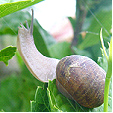
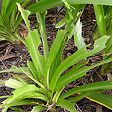
Appearance and Distribution of the Pest
Slugs and snails occur world-wide. Slugs tend to be more prevalent in heavier soil types.
Life Cycle
These insects have a Hemimetabolous life cycle, ie. When the immature nymphs resemble the adults.
Snail eggs are laid in moist soil, 20-40mm deep; eggs are white, spherical and appear in clusters of 30-100. Under favourable conditions, eggs hatch in 2-3 weeks. Newly emerged snails resemble tiny adults. When the weather is cold and dry, snails seal themselves into their shells where they survive, dormant, for 1-3 years.
Period of Activity
More active during the warmer months, although some species may remain active throughout the year.
Damage Caused
Native Australian slugs and snails are not commercial pests. Introduced species chew holes in foliage or skeletonise leaves; some plants may be completely defoliated plants; tubers and seedlings may be completely eaten. Slugs and snails feed mainly at night, especially after rain or watering; they shelter in cool, moist locations during the day. When the weather is dry, snails seal themselves into their shells with a mucous membrane, where they survive, dormant, for 1-3 years. Some species may consume up to one third of their body weight each day.
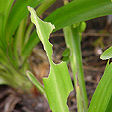
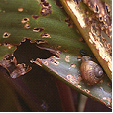
Susceptible Plants
A wide range of leafy plants, including ground crops, potatoes, tubers, leafy vegetables and seedlings.
Fern species are attacked causing serious damage. New fronds are repetitively eaten causing the plant to become stunted. Attacks are normally more severe during wet periods during which time control measures should be taken.
Morinda citrifolia is attacked by the Giant African Snail (Achatina fulica) which defoliates trees.
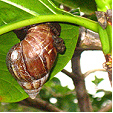

Cultural Control
Remove possible hiding places and avoid overhead watering to reduce humidity. Cultivate soil regularly; in commercial situations, allow the soil to remain fallow for one season to reduce numbers. Domestic infestations may be removed by hand. Traps may be created by inverting small pots near where snails and slugs are feeding; they will gather in these shelters during the day, and may be collected and destroyed. The popular Australian "beer trap" consists of a vertically-sided container, sunk into the ground and filled with beer, which intoxicates and drowns the snails.
Biological Control
Natural predators such as birds, frogs, and lizards reduce numbers, but do not provide effective control. Orchardists have used running ducks to control snails with some success.
Chemical Control
Commercial baits - molluscicides - made from methiocarb or metaldehyde are effective when used in combination with sanitation. Their effectiveness varies according to soil and weather conditions; it is generally recommended to avoid watering after application.
Note
Always read the label for registration details and direction of use prior to application of any chemicals.
Note: Plants affected by this pest are Deer Resistant plants not the susceptible plants.
PEST
NAME
Deer
Cervus species
ORDER
Artiodactyla
FAMILY
Cervidae
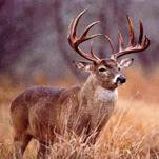
Description of the Pest
There are two species of the deer in North America, the Whitetail (Odocoileus virginianus) and the Mule deer (Odocoileus hemionus) with several regional variations such as the Pacific coastal Blacktail (O.h. columbianus) which is regarded as a sub-species of the Mule deer.
The Whitetail on average grows to 112 cm (44in) tall and 180 mm (70 in) long and weigh 68 kgs (150lbs). The fir colour varies according to its environment but generally it is reddish-brown during summer and grey-brown in winter with a pure white underside on its tail. When the tail is erect it is known as the "white flag". Its antlers consist of two main beams from which the points emerge.
The Mule deer grow to 105 cm (42 in) tall and are up to 200 cm (80 in) long with the adult buck weighing up to 137 kgs (300 lbs) and the does up to 80 kgs (175 lbs). The fir is generally tawny brown during summer and during winter it has a heaver grey-brown to blue-grey coat with a small white tail that is tipped in black. The other distinguishing features are its ears that are up to 300 mm (1 ft) long (mule-like) and its antlers, with the two beams that are forked into smaller beams, which inturn fork again and again.
The Blacktail deer (Pacific coastal Blacktail) grows to 97 cm (38 in) tall and is up to 105 cm (60 in) long and weighs on average 73 kgs (160 lbs). The fir is generally tawny brown during summer and during winter it has a heaver grey-brown to blue-grey coat with a tail that is dark brown at the base then changing to black for 50% of its length. The antlers consist of two beams that are forked into smaller beams, which inturn fork again and again.
Appearance and Distribution of the Pest
The Whitetail deer are found throughout eastern United States, on the coast and inland but are not commonly seen in California, Utah or Nevada. They do not migrate but congregate together (yard up) during winter and feed in a part of their existing territory.
The Mule Deer are found in the western part of North America from South eastern Alaska to Mexico and from the Pacific coast to Texas. They migrate from highland mountain meadows to southern or lower snow free forested valleys during winter.
The Blacktail deer are found on the Pacific coast from Alaska to northern California. There is both resident and migratory Blacktails. The migratory Blacktails move southwards during late autumn at the first sigh of snow or heavy sustained rain and the resident Blacktails seek cover their existing territory amongst woodlands during the winter months.
Life Cycle
All Deer breed from autumn to early winter and the does give birth from late spring to early summer.
Period of Activity
Deer are most active from spring to autumn but can be troublesome during winter when the feed is scarce. In some regions urban landscapes become the major food source both in summer and winter.
Damage Caused
Browsing deer will feed on almost any plant and is most commonly noticeable during spring feeding on the new growth or twigs and stems leaving a shredded appearance. Deer also rub their antlers against trees damaging bark and snapping off small branches, this action also incurs damage under hoof as plants, lawns and garden structures are trampled on.
Susceptible Plants
Some plants are more palatable to deer but when a deer is hungry or during drought conditions there are no "Deer Proof" plants. There is a range of plants that have a bad taste and are not destroyed and are regarded as (deer resistant plants). Deer resistant plants are the plants that are attached to this file not the susceptible plants.
Cultural Control
There are many cultural controls that have been tried to move browsing deer such as frightening them with strobe lights, pyrotechnics or tethered savage dogs. These actions are only temporary and may cause more trouble as the stampeding animals move off. Fencing and netting can be an effective method of discouraging hungry deer from gardens but may be expensive on a large scale and require maintenance. There are several types of fences which include conventional 2.2m (8 ft) deer-proof woven wire fences or single-wire electric fences and slanted deer fences. Plant selection can also be effective, by using less desirable plants (deer resistant plants) as an outer border to the more desirable plant species and thus discouraging the deer to enter the garden. Hedges and windrows of less desirable thorny plants can also be a deterrent to browsing deer.
Chemical Control
There are two main types of repellents contact and area. Contact repellents are applied directly to the plants and deter deer with a bad taste or smell. They can be applied by rubbing or spraying on to the plants and commonly used in an egg mixture. The commercial products have proven to work better than home remedies which include soap or chilli mixtures and hanging bags of human hair.
Area repellents rely on an offensive odour and are placed around areas that are frequently visited.
Contact your local distributor for available types and application.
Note: Plants affected by this pest are the Rabbit Resistant plants not the susceptible plants.
PEST
NAME
Rabbits
Oryctolagus cuniculus & Sylvilagus species
ORDER
Lagomorpha
FAMILY
Leporidae

Description of the Pest
There are a eight different genera in the family classified as rabbits and include the European Rabbit (Oryctolagus cuniculus) which has infested Australia and the Cottontail rabbit (Sylvilagus spp.) which consists of 13-species with 9-species found in North America.
Generally rabbits have an egg-shaped body that can range in size from 200 mm to 500 mm long and weigh up to 2 kg. They have long ears that are adapted for detecting predators and powerful large hind legs allowing them to move fast. The body is covered in buffed, long soft fur that is brown or grey and the mouth has two sets of incisor teeth which are located one behind the other.
The cottontail rabbit grows up to 450 mm (18 in) tall and weighs 1.36 kg (3 lbs).
Appearance and Distribution of the Pest
Generally rabbits live in a variety of habitats including meadows, woodlands, forests, grasslands or deserts and wetlands living in groups with some underground in borrowers. The European Rabbit has been introduced to many parts of the world and in 1859 Thomas Austin brought 24 breeding pairs to Australia which subsequently escaped and quickly bred throughout Victoria and New South Wales and by the 1900's the rabbits had reached the Northern Territory and Western Australia.
Life Cycle
The life span varies with each species. Cottontails for example can live for one year to a maximum of three years in the wild but in captivity they can last for eight years, during which time they can raise between 2-6 litters per year and produce up to 18 kittens during the breeding season. In the cooler northern parts of North America the size and number of litters are generally smaller only 2-3 but in southern regions such as Mexico or Australia, European rabbits can produce 5-6 litters per year, normally commencing during spring time and continuing throughout the year. Each litter can consist of 2-8 or more kittens. Under ideal seasonal conditions a mature doe (female) can mate again several hours after giving birth and has a gestation period from 28-30 days.
Period of Activity
Generally rabbits eat throughout the year but in cooler countries such as North America they are more active during the spring to summer period but in warmer climates such as Australia rabbits can cause significant damage throughout the year.
Damage Caused
in Australia the effects of rabbits on the landscape has been a devastating resulting in the loss of an unknown number of plant species and a ring barking of young trees in orchards or forests. Major erosion problems have also resulted from warrens or plant denuded landscapes which are left vulnerable to the elements.
A rabbits generally will eat most flowers or the bark of woody plants, grasses of all types and most agricultural crops (vegetables).
Susceptible Plants
Rabbits mainly consumed grasses or garden vegetables and a broad range of ornamental plants. In cool climates where snowfalls rabbits eat twigs, bark and buds from the dormant plants. When rabbits are hungry they will eat most plants but attached to this file are rabbit resistant plants that are less palatable. Their resistance will vary depending on the stage of growth as new shoots are very desirable to rabbits.
Cultural Control
Control methods include trapping, hunting and exclusion with the use of fences, all of which had a marginal success. Many predators utilise rabbits as a food source for example foxes, feral dogs and cats, hawks or owls and human hunters.
Biological Control
In Australia to biological diseases have had reasonable success. In 1950 Myxomatosis was released into the rabbit population and resulted in the numbers dropping from 600 million to 100 million. Remaining populations became immune and steadily increased numbers to 300 million by the 1990s. The calicivirus was accidentally released in 1996 and culled populations significantly in regions of extreme heat but was less effective in cooler regions where the rabbits were exposed to a lesser calicivirus that immune them.
Chemical Control
Baiting and chemical repellents programs relied on the territorial habits of rabbits as they rarely forage further afield from their territorial areas.
Note
Landholders should seek advice from their local government agencies. This advice will include fumigation or destruction of warrens, fencing and shooting.
Average Lowest Temperature : -10º C 14º F
USDA : 5, 6, 7, 8, 9, 10
This USDA (United States Department of Agriculture) hardiness zone chart can be used to indicate a plant’s ability to withstand average minimum temperatures. However, other factors such as soil type, pH, and moisture, drainage, humidity and exposure to sun and wind will also have a direct effect on your plant’s survival. Use this chart only as a guide, always keep the other factors in mind when deciding where, when and what to plant.
A plant's individual USDA zone can be found in the Plant Overview.
Climate Description
Cool to Cold
These zones have low winter temperatures with moderate humidity and moderate summer temperatures.
Frosts and snow are severe. Droughts rarely occur and wind is cold.
Plant growth
Endemic native and exotic cool climate plants grow well within these zones.
| Dictionary | Growth Habit |
| Leaf Type | Botanic Flower Description |
| Leaf Shape | Flower Inflorescence |
| Leaf Arrangement | Fruit Type |
| Leaf Margin | Bark Type |
| Leaf Apex And Bases | Flower Description |